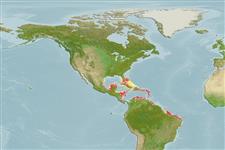Common names from other countries
Environment: milieu / climate zone / depth range / distribution range
экология
; солоноватоводный; пределы глубины 2 - 15 m (Ref. 415). Tropical
Western Central Atlantic.
Length at first maturity / Size / Вес / Возраст
Maturity: Lm ? range ? - ? cm Max length : 0.2 cm OT самец/пол неопределен; (Ref. 415)
Encrusting sponge, 0.1 - 0.2 cm thickness. Smooth, and slippery surface, with regularly dispersed oscula: 0.2 - 0.3 cm in diameter. A conspicuous star-shaped canal system surrounds each oscula (Ref. 415). Color: light to dark blue or violet. Leathery (Ref. 85482).
Maximum body thickness: 0.2 cm (Ref. 415).
Life cycle and mating behavior
половая зрелость | размножение | нерест | икра | Fecundity | личинки
Members of the class Demospongiae are hermaphroditic. Life cycle: The zygote develops into parenchymella larva (free-swimming) before settling down on a substrate where it grows into a young sponge.
Основная ссылка
ссылки | координатор | соавторы
Collin, R., M.C. Díaz, J. Norenburg, R.M. Rocha, J.A. Sánchez, M. Schulze, A. Schwartz and A. Valdés. 2005. (Ref. 415)
Статус Красного Списка МСОП (Ref. 130435: Version 2024-1)
Статус СИТЕС (Ref. 108899)
Not Evaluated
Not Evaluated
Угроза для людей
Harmless
Использование человеком
| FishSource |
инструменты
дополнительная информация
ресурсы в Интернет
Estimates based on models
Preferred temperature
(Ref.
115969): 26.4 - 28.2, mean 27.5 (based on 517 cells).
Уязвимость
Low vulnerability (10 of 100).
Категория цены
Unknown.
